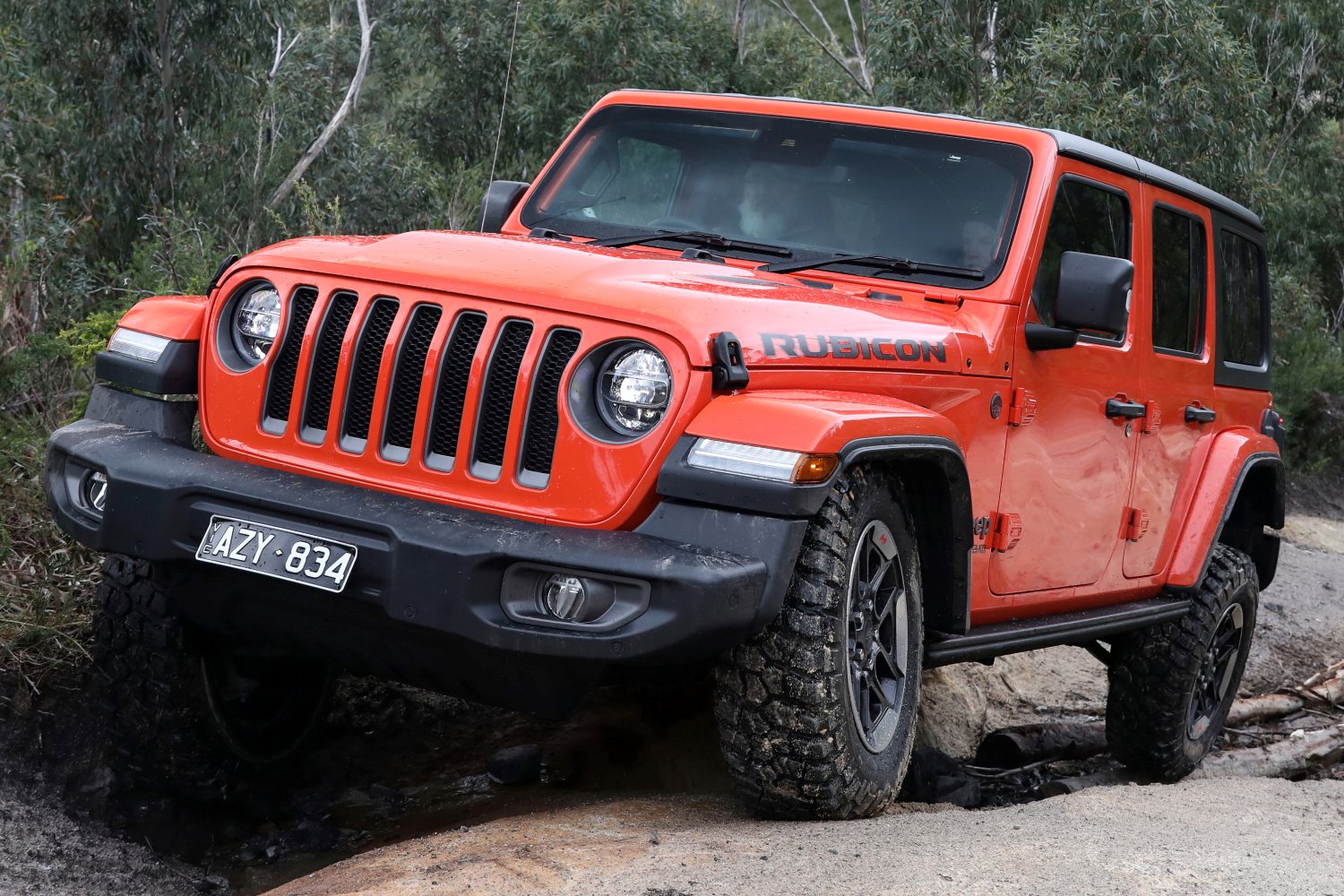Wheels first drive review
Overall Rating

5 0 5
Plus & Minus
WHAT IS THE JEEP JL WRANGLER RUBICON?
Key to the Rubicon’s ability are its mud terrain tyres, low gearing and locking differentials; features that no other vehicle manufacturer is prepared to include in a production car. They are just part of the Rubicon’s off-road arsenal, which also includes a disconnecting front sway bar to allow more suspension travel and high ground clearance.
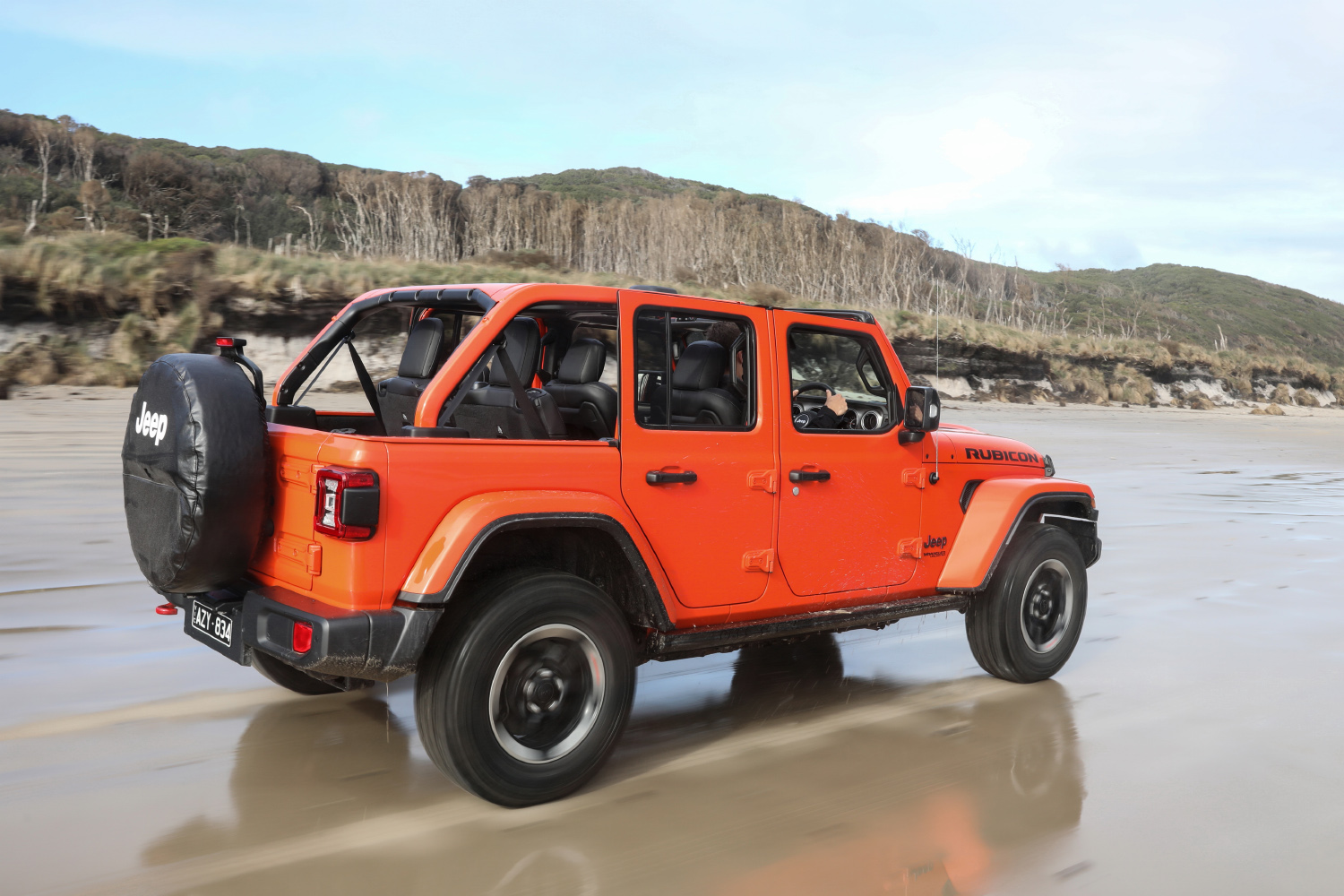
WHY WE’RE TESTING IT
The JL is the fourth generation of the Jeep Wrangler since the nameplate debuted in 1986, but it draws its DNA from the WW2 Jeep from 1948. The JL has just arrived in Australia after being available in the USA for more than a year and it’s here to defend its title as the most off-road capable four-wheel drive vehicle available.
JEEP JL WRANGLER RUBICON REVIEW
The Jeep Wrangler is not everyone’s cup of tea, but it has a unique style that honours its long heritage and appeals to many buyers wanting to at least look like they are ready to take on the world’s toughest off-road trails. They’d be giving themselves the best chance of conquering those trails if they took them on in the 2019 Wrangler Rubicon.
The name Rubicon itself, is taken from the legendary trail in Northern California where Jeep puts its 4×4 vehicles to the test on the boulders and slopes. The moniker is applied to the top-of-the-range Jeep Wrangler; the one with the most off-road features and ability.
But the Wrangler is not all about off-road driving. In fact Jeep Australia admits that its own research tells them that only 12-per cent of buyers choose Wrangler for its off-road ability while more than 25-per cent buy it on its style. The company has stayed true to its design heritage in the evolution of the model, comparing the Wrangler to Porsche’s 911 sports car, which also has more than 70 years of tradition, yet is instantly recognisable regardless of the era each one came from.

One thing buyers won’t be drawn to the Wrangler for its safety rating, as it has been awarded a poor 1-star ANCAP score based on its Euro NCAP tests. That’s not totally fair on the Jeep as the European test was on a 2018 model car that was not fitted with electronic safety tech such as Autonomous Emergency Braking (AEB), blind spot monitoring and rear cross traffic alerts in addition to the ABS, ESC, airbags and electronic roll mitigations systems. While these electronic systems will aid accident avoidance, they fail to address the poor occupant protection noted in the Euro NCAP testing where deformation of the A-pillar and driver-side (LHD) footwell were criticised. A 2019 model car with the full suite of electronics is yet to be crash tested and rated.
For the remainder of 2019, only the mid-spec Wrangler Overland and top-spec Rubicon variants come with the full gamut of safety electronics. The entry level Sport S models will have to wait until 2020 to join them with life-saving tech such as AEB and rear cross traffic alerts.
If you can ignore the safety rating and put yourself behind the wheel of a Wrangler Rubicon you will be rewarded with a more refined driving experience that any Wrangler before it. Yes those mud terrain tyres which are exclusive to the Rubicon variant, rumble and holler on the highway and the lofty suspension leans heavily through corners. However, these are compromises that enthusiasts are prepared to accept to get the superior off-road performance.
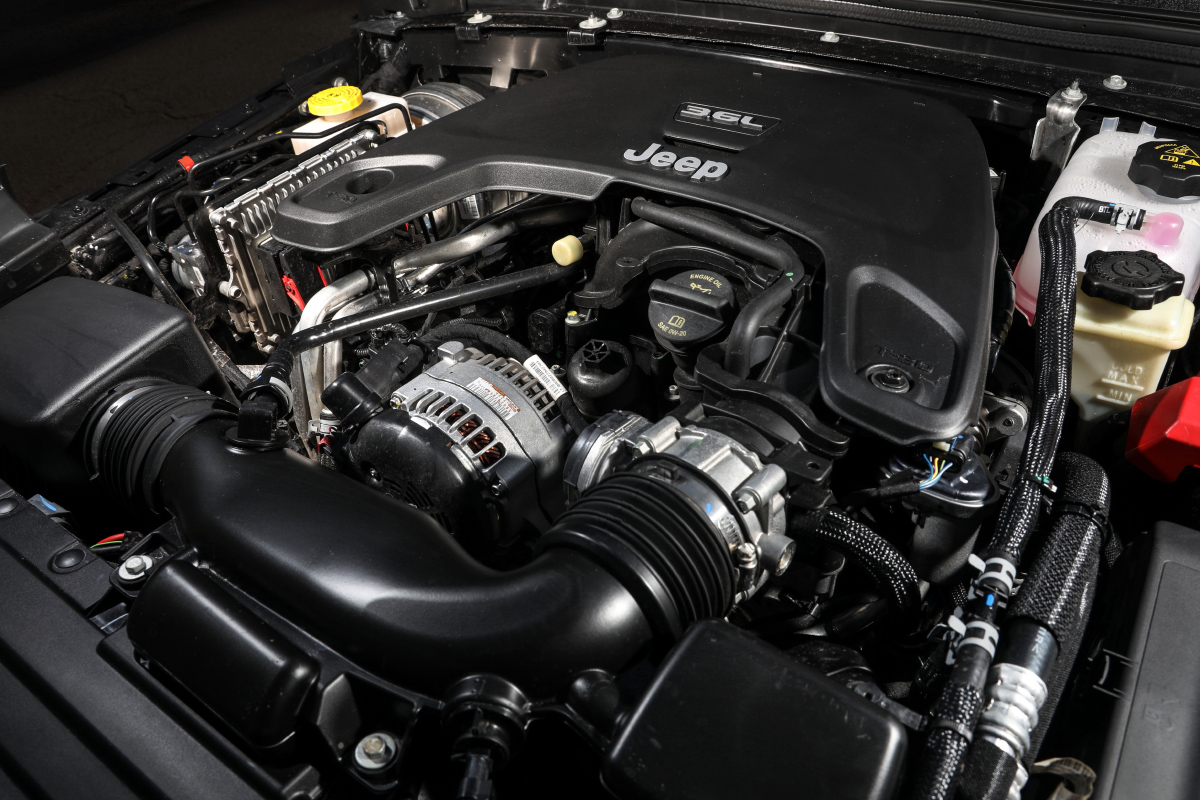
The Wrangler steers and handles better than in the past and the new diesel engine and eight-speed auto combination provides swift if not fast performance. The engine delivers its 450Nm of torque from low revs, and is smooth and relatively quiet for a diesel. This in a new 2.2-litre engine that shares nothing with the old 2.8 from the previous Wrangler where is wasn’t offered in the Rubicon spec. It has been seen previously in the Jeep Cherokee and Alfa Romeo passenger cars.
This engine works well both on- and off-road, with the new eight-speed ZF auto to keep the engine in its happy place and deliver drive to the wheels in technical terrain. The auto is also the transmission offered behind the petrol engine – a 3.6-liter V6 carried over from the previous model.
The cabin of the 2019 Rubicon is also more appealing than in the past. More use of soft-touch surfaces, stitched dash coverings, rubberised dials on HVAC and audio controls give the interior a more upscale feel, especially when equipped with the optional (in Rubicon) leather seats.
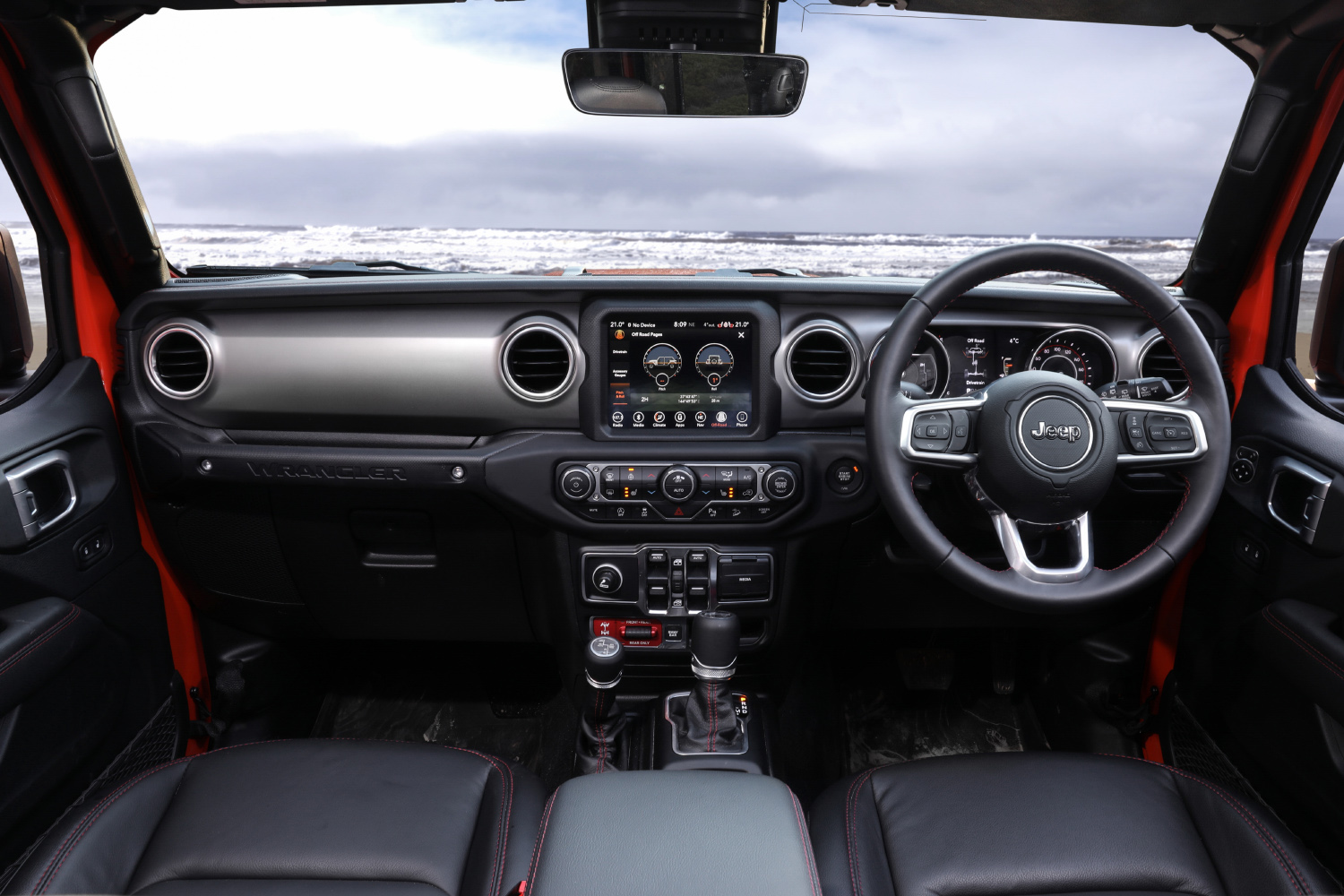
Jeep’s launch program on Tasmania’s wild west coast took us over an off-road track that no other production 4×4 vehicle would conquer without risk of serious damage or getting stuck. Even the mighty Rubicons needed recovering a couple of time to get through.
With front swaybars disconnected the convoy of Jeeps crawled their way through the ruts and holes where lesser 4×4 would have been lifting wheels and losing traction. When the track got slipperier, front- and rear-locking differentials were employed to ease the way forward, but leaving the diffs open and allowing the electronic traction control to do its thing, equally impressed. Jeep has obviously done a lot of work on the calibration of its ETC and it is now faster reacting and more capable of driving the vehicle forward without resorting to the lockers.
Ground clearance was tested on the long wheelbase Jeeps with the underside often scraping over rocks and ruts. Luckily it is well protected with metal underbody plates so drivers could feel confident of not doing damage.
While we’re yet to drive the Sport S and Overland variants of the new Wrangler, this drive was enough to convince us that the Rubicon is still the off road king. Add in the improved refinement and extra features and the JL is a better vehicle than its predecessor but whether that’s enough to have buyers look past the safety rating and the price hike remains to be seen.
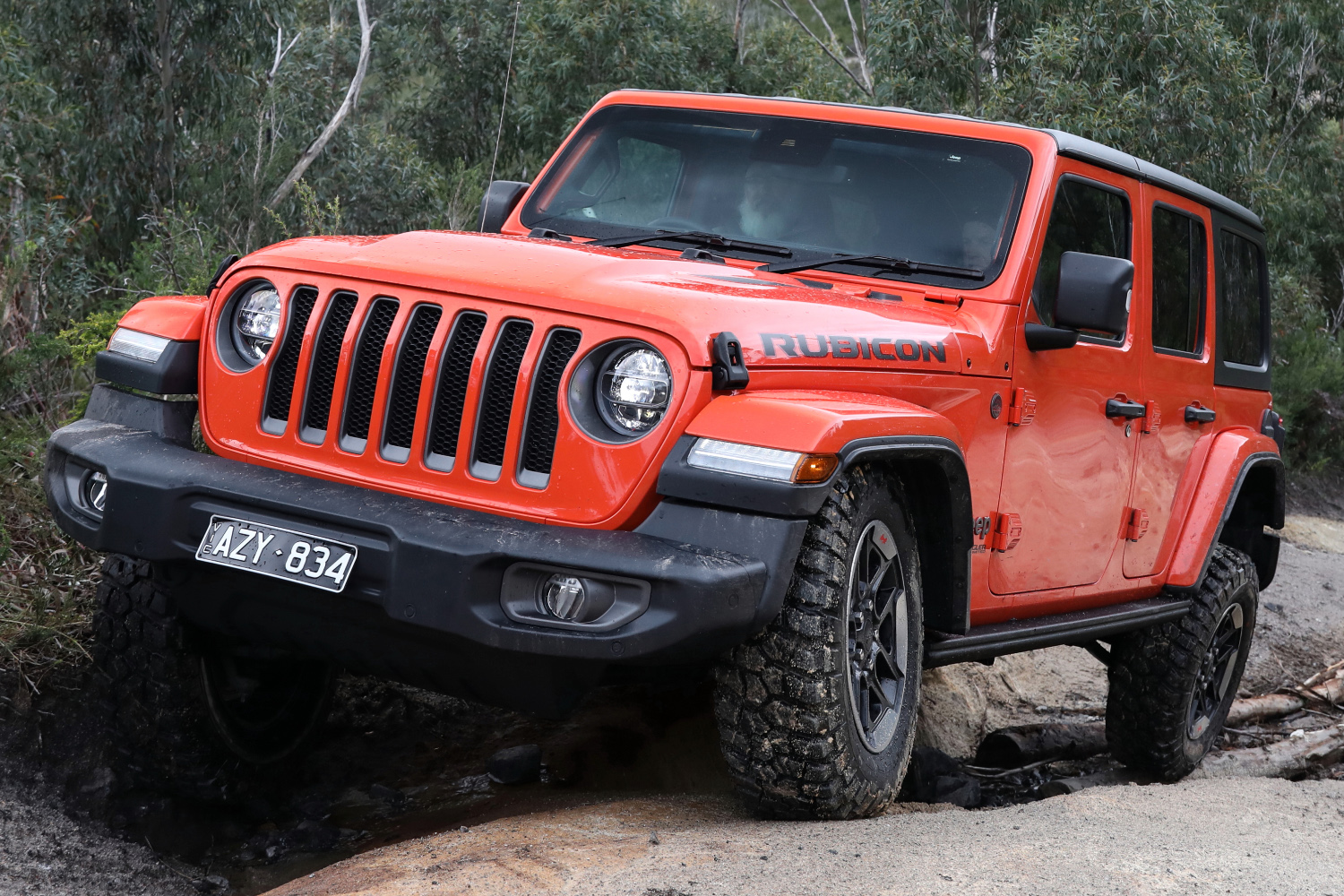
JEEP JL WRANGLER RUBICON VS RIVALS
The Jeep Wrangler Rubicon really has no direct rivals as there is nothing like it available today. The two vehicles closest to it are the Toyota Land Cruiser 76 Series and the Suzuki Jimny as they are body-on frame, off road vehicles, yet both of them are very different to the Jeep.
The Land Cruiser is more of an outback workhorse than the relatively plush Wrangler. It has a basic interior, leaf spring rear suspension and available withV8 diesel engine a 5-speed manual gearbox only. Priced from $63,740 to $ 67,740 it is close to the Rubicon.
The $23,990 Suzuki Jimny on the other hand is a two-door compact 4×4 wagon that comes with a four-cylinder petrol engine and a choice of manual or auto transmissions. It’s more of an urban adventure vehicle yet one that can hold its own when the going gets rough.
JEEP JL WRANGLER RUBICON PRICE AND SPECS AUSTRALIA
Model: Jeep JL Wrangler Rubicon diesel
Engine: 2.2L I4 turbodiesel
Max power: 147kW @ 3,500rpm
Max torque: 450NM @ 2,000rpm
Transmission: 8-speed automatic
Weight: 2160kg
0-100km/h: 9.6 sec (claimed)
Economy: 7.5L/100km combined
Price: $68,950 +ORC
On sale: Now
4×4 Australia off-road review
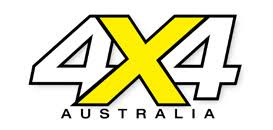
4X4: Australia’s guide to the off-road adventure lifestyle. Mixing in-depth vehicle reviews with off-the-beaten-track adventures and gear tests, 4X4 is all about enjoying Australia’s great outdoors.
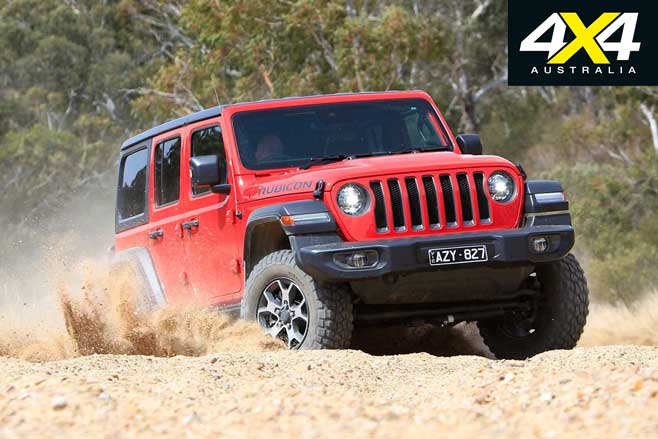
More power and a lower sticker price make the case for the petrol ‘six’ over the turbo-diesel ‘four’ in the Rubicon. By: Fraser Stronach Photos: Phil Cooper
The Rubicon is the off-road hero of the new Jeep JL Wrangler range, and for the first time ever a Rubicon is offered with turbo-diesel power thanks to a brand-spanking-new Fiat-sourced 2.2-litre four.
However, the little Italian oiler isn’t the only engine in the game. For $5500 less initial outlay, and with lower ongoing service costs thanks to its relative simplicity, there’s the familiar 3.6-litre petrol V6, which also happens to offer more than 40 per cent more power and a fair bit more maximum performance.
Powertrain and Performance
The Pentastar V6 was state-of-the-art when it debuted 10 years ago at the New York Auto Show. All alloy, short stroke, quad cam, 24-valve, variable timing on both inlet and exhaust, sequential multi-point fuel injection … it had all the tricks of the time for a naturally aspirated petrol engine. For the next three years it featured in the prestigious Wards Ten Best Engines and, on arrival in Australia in 2010, in the then all-new Grand Cherokee, it won our 4X4 Of The Year award.
But that was 10 years ago and engine design has moved on, and nowhere is that more telling than in the engine speeds that this V6 needs to get the job done. To give its all it needs to rev all the way to a dizzy 6400rpm.
Thankfully it doesn’t need to give its all, or anywhere near that, to handle most driving where 2000 to 3000rpm is all you’ll see. At lower engine speeds and lighter throttle loads it’s generally quieter than the diesel alternative, and it goes about its work in a relaxed and pleasant enough manner.
However, put more demand on the engine – on the highway and especially on hills – and the eight-speed automatic is quickly looking for a lower gear, or three, due in part to the very tall overall gearing, despite the V6 using a lower axle ratio than the diesel.
At 110km/h in top gear the engine’s only doing 2000rpm, so it’s a long way from where it reaches maximum torque (4100rpm) and even more of a stretch to where it makes maximum power at 6400rpm. If the Rubicon V6 could reach redline in top it would be doing close to 360km/h, so it’s effectively geared nearly twice as tall as it needs to be. All done in the interests of fuel economy and refinement, of course.
Still, even when singing along on the high side of 4000rpm, which can be common enough on hilly country roads even without a particularly heavy right foot, the V6 is more than willing and happy enough, even if it starts to get a bit noisy.
The positive with all these revs is that the V6 goes a fair bit harder than the diesel when both are asked to give their all. Jeep’s own figures put the V6 nearly two seconds quicker than the diesel to 100km/h and, while you may not see drag racing as part of your Rubicon’s driving regime, the extra highway overtaking get-up-and-go is definitely more than welcome.
The V6 couldn’t do what it does best, though, without help from the new eight-speed automatic gearbox. This widely used gearbox is from German transmission specialist ZF and is about as good as it gets in terms of shift quality, which is often seamless, or shift timing, which always seems perfect (or close to).
Of course, this is also an adaptive gearbox that tailors the shift protocols for your driving style, which makes it even better; and it’s a big jump forward from the previous Mercedes-Benz-sourced five-speed automatic, which in itself was a good gearbox. If you want a manual gearbox you’re unfortunately out of luck, as the eight-speed auto is the only gearbox on offer with both the V6 and the diesel.
The elephant in the room with the V6 is, of course, fuel economy, as all those high engine speeds and wider throttle openings don’t come for free. On this test the V6 averaged 14.7 litres/100km, while under similar driving conditions a recently tested diesel averaged 11.5 litres/100km – a not unexpected outcome on both counts given the blunt aerodynamics and extra rolling resistance of the Rubicon’s mud tyres.
The extra fuel cost of the V6 may or may not be of concern to you, but the V6’s shorter range is an inescapable disadvantage unless you can fit a long-range tank. The standard 81 litres makes for a reasonable but not great range with the diesel, but things aren’t so good with the V6 as the range is down to around 500km, or less if you’re doing extended low-range driving.
On Road Ride and Handling
In a significant change from the previous generation Rubicon – indeed, all previous Wrangler models – the JL offers full-time 4×4 via its ‘4H Auto’ mode, which can be used on any road surface, sealed or unsealed, wet or dry, and gives better drive and steering stability especially on wet bitumen and gravel.
Given the extra power of the V6, the full-time 4×4 is even more welcome than it is with the tamer diesel, as you can get more power to the ground on slippery roads without the risk of wheelspin and subsequent loss of engine power as the electronic traction control intervenes. The transfer case still has a two-wheel-drive mode, so it should keep everyone happy!
The Rubicon V6 – or diesel, for that matter – still isn’t a particularly dynamic on-road drive. The steering is light and doesn’t offer a good deal of feel or precision. There’s also some bump steer from both front and rear axles on rough roads, especially at higher speeds.
The BFGoodrich Mud-Terrains aren’t the last word in on-road grip, either, and are generally noisy; although, this varies with the road surface. Depending on your driving regime, all-terrain tyres, such as the excellent BFGoodrich KO2 All Terrains, might be a better bet.
Off Road
What the diesel Rubicon can do off-road, the V6 can do too; although, with some differences. The V6’s immediate off-idle response is more linear and progressive than that of the diesel, but from then on it takes more throttle and more revs to give the same drive as the diesel, as the diesel makes far more torque at much lower revs than the V6.
Where the diesel can muster 450Nm at just 2000rpm the V6 needs more than twice that engine speed to reach its peak torque, and it still falls 100Nm short, give or take, of what the diesel can offer. Still, much of this is masked off-road by the excellent eight-speed automatic.
With either engine, the Rubicon is as good as it gets in terms of showroom stock off-road ability, as it’s effectively ‘pre-customised’ for off-road use compared to the other already off-road-capable Wrangler models.
Rubicon-specific kit runs to front and rear driver-switched diff locks, a front swaybar release which, when activated, adds to the already impressive front wheel travel, and the Rock-Trac transfer case with its 4.0:1 low-range reduction ratio. The Rock-Trac transfer case helps give the V6 an off-the-chart 77.2:1 crawl ratio. Even the Rubicon diesel, with its taller axle than the Rubicon V6, has a 70.3:1 crawl ratio. The 255/75R17 (32-inch) Mud Terrains are also unique to the Rubicon.
If there’s a weak-link in the Rubicon’s off-road armoury, it’s ground clearance, in particular the ramp-over clearance; although, it’s well protected underneath for when you do belly out. The two-door Rubicon has a far superior ramp-over angle, but unfortunately it isn’t offered here in Australia.
Bigger tyres – even one size up to a 285/70R17 (33-inch) – will help and will be the likely first-up upgrade for owners, while a snorkel might not be far behind.
Beef Up
US model Rubicons get wider and taller 285/70R17 (nominally 33-inch) BFGoodrich Mud-Terrain tyres rather than the 255/75R17 (nominally 32-inch) tyres fitted to Australian Rubicon which, apart from making the rig look a bit tougher, give a little more ground clearance.
Apparently the axle joints (universal versus CV) used in conjunction with the part-time-only transfer case of the US models are stronger, so can happily wear the bigger tyres. While fitting these tyres to an Australian-spec Rubicon shouldn’t be a problem, fitting notably bigger tyres (35-inch, etc.) without some aftermarket re-engineering may be.
Cabin, Accommodation & Safety
Jump in the Rubicon and it immediately feels like an old-school 4×4 in terms of the ‘square’ cabin, upright seating position and flattish dash and windscreen. At the same time the Rubicon has a busy and modern feel, with big touchscreen and all.
Tilt-and-reach steering wheel adjustment and plenty of height adjustment on the seat are positives, but the driver’s footwell is narrow and can feel a bit cramped. The upright cabin also provides plenty of headroom in a rear seat that can take three adults at a squeeze but is happier with two adults and a child in the centre, or three children. The cargo area isn’t huge, but it does have adjustable tie-down points.
If the Rubicon’s cabin feels a bit closed in, which it can do, the panels above the driver and passenger can be easily removed to give a largely open-air driving experience. And if you want the full ‘beach buggy’ experience, the entire roof can be removed; although, this is a far more complex operation that requires at least two people to perform.
When initially accessed, this generation Wrangler (Rubicon included) somewhat controversially only gained a one-star ANCAP safety rating, but it has since been fitted with new safety systems such as automatic emergency braking.
Practicalities
The V6 has an extra 100kg payload over the diesel, which still isn’t much at 500kg. The V6 also matches the diesel’s relatively low towing capacity, which is just shy of 2500kg. Useful enough for a camper trailer but neither Rubicon is a heavy-duty tow rig.
Fixed-price service costs for the first five years are $299 per year for the petrol as against $499 for the diesel. Both have one-year service intervals, but if you’re doing lots of kilometres the V6 needs servicing at least every 12,000km while the diesel can stretch to 20,000km, which will affect the service-cost difference if you do more than 12,000km a year.
What You Get
Standard equipment runs to smart-key entry and push-button start, tilt-and-reach steering wheel adjustment, an 8.4-inch touchscreen, embedded sat-nav, dual-zone climate, Apple CarPlay and Android Auto, automatic headlights, a rear-view camera, and a nine-speaker Alpine premium audio system with a massive subwoofer in the rear cargo area.
Autonomous emergency braking, blindspot monitoring, rear cross-traffic alert and adaptive cruise control headline the safety kit; although, only four airbags – two front and two side – are fitted. USB ports are fitted front and rear, and there’s a 230V/150W outlet in the rear seat area. The cargo area gets a 12V outlet and adjustable (sliding) cargo tie-downs. Options run to leather, heated seats up front, a heavy-duty battery/alternator and some cosmetic kit.
Sum Up
So does the V6 make a good case for itself compared to the diesel? Initial back-to-back impressions of the two would suggest not, as the diesel is notably more responsive in give-and-take driving and far more relaxed as it doesn’t need to shuffle up and down the gears as much to do the same job, even if the slick eight-speed auto does this with little fuss with the V6. Countering this, the V6 has pedal-to-the-metal performance the diesel can’t match.
The V6 loses on fuel consumption, which has a negative effect on range and filling frequency, not to mention the fact you’re always forking out more money on fuel (around 30 per cent with diesel-petrol price parity).
However, if you factor in the $5500 initial sticker-price savings and the potential $1000 service-cost savings over five years, you should be able to drive 137,000km before you spend your ‘savings’, assuming that both petrol and diesel are $1.50 a litre.
Ownership beyond the fixed-price servicing and warranty period also looks better for the V6. Unlike the diesel, there’s no turbo, no DPF and no AdBlue to ruin your day.
JEEP WRANGLER RUBICON V6 SPECS Engine: 3.6-litre V6 petrol Max Power: 209kW @ 6400rpm Max Torque: 347Nm @ 4100rpm Gearbox: 8-speed auto 4×4 System: Dual-range/full-time (+2wd) Crawl Ratio: 77.2:1 Construction: Separate chassis Front suspension: Live-axle/coil springs Rear suspension: Live-axle/coil springs Kerb Weight: 2053kg Payload: 509kg GVM: 2562kg Towing Capacity: 2495kg GCM: 4808kg Departure angle: 31.9° Rampover angle: 21.2° Approach angle: 41.7° Wading depth: 760mm Ground clearance: 252mm Fuel tank capacity: 81L ADR fuel consumption: 10.3L/100km On-test fuel consumption: 14.7L/100km Test fuel range: 501km
JEEP WRANGLER PRICING* Sport 2dr V6: $48,950 Sport 4dr V6: $53,450 Overland 2dr V6: $59,450 Overland 4dr V6: $63,950 Rubicon V6: $65,450 Rubicon Diesel: $70,950


